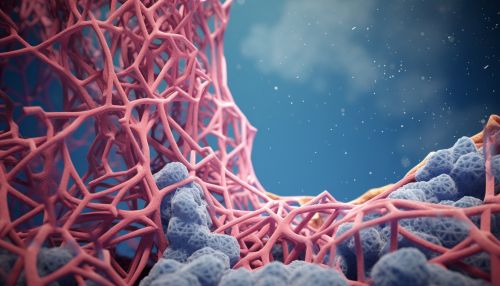Lung cancer
Overview
Lung cancer, also known as lung carcinoma, is a malignant lung tumor characterized by uncontrolled cell growth in tissues of the lung. This growth can spread beyond the lung by the process of metastasis into nearby tissue or other parts of the body. Most cancers that start in the lung, known as primary lung cancers, are carcinomas. The two main types are small-cell lung carcinoma (SCLC) and non-small-cell lung carcinoma (NSCLC). The most common symptoms are coughing (including coughing up blood), weight loss, shortness of breath, and chest pains.


Causes
The majority of cases of lung cancer are due to long-term tobacco smoking. About 10–15% of cases occur in people who have never smoked. These cases are often caused by a combination of genetic factors and exposure to radon gas, asbestos, second-hand smoke, or other forms of air pollution. Lung cancer can be seen on chest radiographs and computed tomography (CT) imaging. The diagnosis is confirmed by biopsy which is usually performed by bronchoscopy or CT-guidance.
Types
Lung cancers are classified according to histological type. This classification is important for determining both the management and predicting outcomes of the disease. Lung cancers are carcinomas – malignancies that arise from epithelial cells. Lung carcinomas are categorized by the size and appearance of the malignant cells seen by a histopathologist under a microscope. For therapeutic purposes, two broad classes are distinguished: non-small-cell lung carcinoma and small-cell lung carcinoma.
Symptoms
The symptoms of lung cancer can vary greatly, but common symptoms include: a cough that doesn't go away or gets worse over time, constant chest pain, coughing up blood, shortness of breath, wheezing, or hoarseness, repeated problems with pneumonia or bronchitis, swelling of the neck and face, loss of appetite or weight loss, and fatigue.
Diagnosis
Diagnosis of lung cancer is made by a combination of chest radiography and computed tomography (CT) scans, followed by bronchoscopy or CT-guided biopsy for histopathological confirmation. The tissue diagnosis from the biopsy indicates the type of cancer and allows the healthcare provider to determine the appropriate treatment.
Treatment
Treatment depends on the cancer's specific cell type, how far it has spread, and the person's performance status. Common treatments include palliative care, surgery, chemotherapy, and radiation therapy. Targeted therapy of lung cancer is growing in importance for advanced lung cancer.
Prognosis
The prognosis of lung cancer is poor because of both local spread and distant metastasis. At the time of diagnosis, only 15% of lung cancer cases are found at an early stage when surgical intervention can be potentially curative. The overall 5-year survival rate for lung cancer in the United States is 18%.
Epidemiology
Lung cancer is the most common cause of cancer-related death in men and second most common in women after breast cancer. The global total of deaths from lung cancer is increasing annually, due to both an increase in the number of smokers and an aging population in many countries.
Prevention
Prevention of lung cancer includes both quitting smoking and improving indoor and outdoor air quality. While in most developed countries, industrial and domestic pollution has been reduced, in many developing countries, this is not the case.
